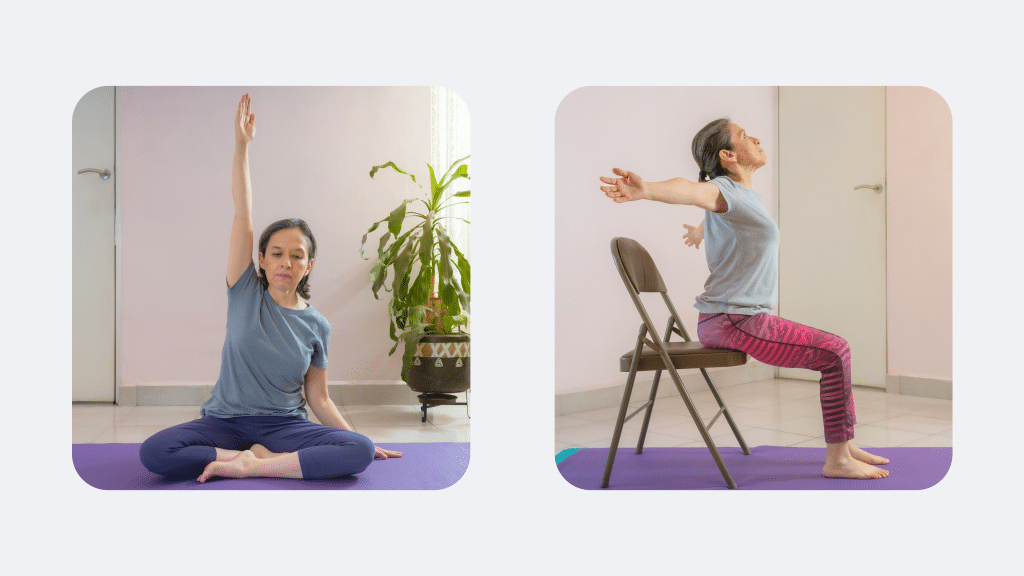Stepping into the world of somatic exercises can be an exciting time as they come with many potential incredible benefits. Somatic exercises can become second nature with practice, they don’t take a lot of time, and they can even be done in the comfort of your own home.
Whether you’re focusing on somatic exercises, somatic workouts, somatic therapy, somatic experiencing, or somatic healing, each of these carries many benefits that can help change and improve your quality of life. However, when starting these exercises, releasing tension, and retraining your nervous system, people sometimes experience side effects before they start to see any benefits (1).
As with any new workout regime or exercise, your body may experience muscle stiffness as it becomes used to these new movements. In this blog, we’ll discuss the benefits of somatic exercises, the side effects of somatic exercises, and how you can start comfortably practicing these movements.
Do Somatic Exercises Really Work?
Before we dive into whether somatic exercises work, let’s first define what somatic exercises are. The term “somatic” means “of, related to, or affecting the body” (2). Somatic exercises focus on the mind-body connection between physical sensations and mental and emotional states and listening to signals from your body regarding pain and discomfort (3). Some examples of somatic exercise include walking meditations, diaphragmatic breathing, yoga, and grounding.
Somatic exercises are known to be quite beneficial for people. While more conclusive evidence is required, some studies have proven that somatic exercises help manage chronic discomfort, support positive emotions, improve balance and mobility, and reduce anxiety (3).
Using somatic exercises can help you become more aware of areas of pain, discomfort, or tension in your body that need to be released or attended to. One of the most notable benefits of somatic exercises is that they can significantly reduce stress when done consistently (3).
In addition to physical benefits, somatic exercises can improve your mental and emotional state. A person can achieve this by becoming more in tune with their mind and body, which encourages them to have increased self-awareness, reduced stress and worry, and a better emotional state of mind (3).
Do Somatic Exercises Release Trauma?
When individuals experience a traumatic event, the trauma and emotions they go through can become trapped in their bodies. Trauma can be held in the body and present itself in physical symptoms for many years. These symptoms can include headaches, chronic pain, dissociation, and muscle tightness (4).
Somatic exercises have been proven to be effective for releasing trauma from the body. We store experiences in different parts of our bodies as a result of accidents, injuries, or emotional traumas (5). Once you’ve pinpointed the various areas in your body that are holding onto trauma and tension, you can perform specific exercises to target these areas and release the tension. It is recommended when you start any type of somatic exercise work focusing on trauma that you receive the support of a trained mental health professional.
The type of somatic therapy that focuses on treating trauma and PTSD is called somatic experiencing and needs to be done with the help of a professional (6).
Read More: List of Somatic Exercises for Mental and Physical Well-Being
Main Benefits of Somatic Exercises
People who perform these exercises consistently can experience the benefits of engaging in somatic exercises. One of the best parts of somatic exercises is that individuals of all ages, abilities, locations, and fitness levels are able to perform them in the comfort of their own homes.
Somatic exercise benefits include (7):
- Reduced stress
- Improvement in posture and flexibility
- Better balance and mobility
- Better emotional awareness
- Potential release of where trauma is being physically held in the body
Somatic Exercises for Stress
One of the greatest benefits somatic exercises provide is reducing stress. Research has shown there to be a correlation between stress and high cortisol levels. When our bodies are in a consistent state of high cortisol levels, this can lead to weight gain, specifically around the abdominal area (8).
Lowering stress can also improve sleep, lower blood pressure, improve digestion, and reduce muscle tension (9). Some of the best somatic exercises for stress and anxiety are progressive muscle relaxation, grounding, yoga, and body scans (10).
Side Effects of Somatic Exercise
Somatic exercises are generally considered safe for everyone. However, with any new physical activity, there may be side effects, particularly when you first start. As a rule, it’s always best to consult your physician before trying a new exercise.
The main purpose of somatic exercises is to release chronic tension in the muscles. However, whenever we work on retraining and releasing the muscles, this can come with a variety of sensations. While the end result may feel much better, some of these sensations can be unpleasant (1). Many of these sensations will only be temporary as your body adjusts. Somatic exercises side effects may include:
- Nausea
- Dizziness
- Feeling off-balance
- Muscle twitching
- Muscle soreness, tightness, or pain
- Headache or migraine
- Emotional release
You can adjust your routine by practicing somatic exercises less frequently, such as every other day or just a few days a week, or you could shorten your somatic exercises from around 20–30 minutes to 5–10 minutes a day as your body becomes used to these new movements. If the discomfort persists, make sure to receive guidance from your medical team on how to proceed.
Somatic Exercise Side Effects
Common Sensations when Starting Somatic Exercise and what Causes Them
You may be wondering what causes these sensations during somatic exercise. Actually, there are different scientific reasons behind each somatic exercise and the sensations or side effects you may experience with them.
The start of a new exercise or movement type can often release habitual muscle tension. By releasing this tension, you’re letting new sensory information into your vestibular system (1). We rely on the vestibular system to keep us balanced and coordinate our movements, so if it experiences changes, we may feel nauseated, dizzy, and off balance. Most of the time, the reason for this is due to the vestibular system being affected by the changes in posture that are caused by practicing somatic exercises (1). Feelings of dizziness, being off-balance, or nausea should only last for a short period of time.
Muscle soreness is also a common side effect when starting somatic exercises. This is mostly caused by moving and stretching muscles you haven’t typically been using. Releasing tight muscles can cause soreness or pain (1). Again, this should only be temporary. If you experience a lot of muscle soreness and discomfort, you should reduce your exercises until your body adjusts to the new movements and consult your medical team for further guidance.
Experiencing soreness or other unpleasant sensations after or during somatic exercises doesn’t necessarily mean you should stop them, it just means that your body is adjusting to them and you may need to take it easy until your body adjusts to them.
If you wish to reach into the deep crevices of your mind, take yourself out of the mental loop, regain balance, infuse yourself with optimism, and cultivate compassion – BetterMe app is exactly what you need!
How to Start a Somatic Practice with the Greatest Comfort
Somatic exercises don’t require any equipment and many of them can be performed very comfortably on a cushioned mat on your floor, in a chair, or even from the comfort of your own bed! It may be possible to better prepare yourself to potentially have fewer side effects of somatic exercise. It’s best to start with gentle and easy exercises. These low-impact exercises will get you used to somatic exercise and help you determine which areas of your body are full of tension.
If you’re wondering how to do somatic exercises and where to start, some of the best exercises are grounding, body scans, diaphragmatic breathing, and yoga.
Grounding
Grounding is the practice of allowing your body to feel stable, calm, and more connected to the earth (11). To do this, you can simply find a comfortable place outside and focus on the present moment and what is around you. You can do this by noticing what you can see, hear, touch, taste, and smell.
Read More: Somatic Movement Exercises to Relax and Destress
Body Scans
Body scans are the process of lying down comfortably on the floor in a relaxed position. You can also lie down in your bed or sit comfortably in a chair. To perform this exercise, you’ll close your eyes and, beginning from the top of your body, slowly do a mental scan down your body to your feet, focusing on every body part as you go.
As you bring awareness to each body part, note any discomfort, feelings, or sensations such as relaxation or tenseness. During a body scan, you’re encouraged to make sure you engage in steady, slow breathing (12). This exercise will help you determine which muscles to focus on and which body parts require attention.
Diaphragmatic Breathing
This exercise helps you strengthen your breathing and relearn proper breathing techniques. To perform this exercise, you can lie on a flat surface, sit, or stand comfortably. If you place one hand on your upper chest and the other below your rib cage, you will be able to feel your diaphragm as you breathe (13).
1) Breathe in slowly through your nose.
2) When you breathe in, your stomach should move out. You can place one hand on your stomach and one hand on your chest to feel this.
3) The hand on your stomach will rise, while the hand on your chest should stay still.
4) Breathe out through your mouth with your lips pursed (as if blowing out a candle).
5) As you breathe out, tighten your stomach muscles so your stomach moves in and your hand on your stomach goes down (13).
FAQs
What happens after somatic exercises?
After somatic exercises, you should feel a release of muscle tension (1). This can be different for everyone, with some people taking longer than others to notice any benefits. You may experience some muscle soreness or pain as your joints shift into alignment and you use muscles that you don’t typically use. To help avoid or reduce any side effects when starting somatic exercises, you should start very gradually and with very low-impact exercises.
Is it normal to feel tired after somatic exercises?
It’s normal to feel tired after somatic exercises as you’re using muscles, focusing on improving your nervous system, and using exertion (14).
Why do people cry during somatic workouts?
It’s perfectly normal to cry during a somatic workout. This is due to the fact that you’re releasing pent-up or stored emotions or working through past trauma (15).
How often should you do somatic exercises?
You can do somatic exercises every day. These exercises can be done at any time. Some people prefer to do them in the morning as a way to start their day grounded, while others prefer to do them right before bed to help them sleep. They can take between 5 and 30 minutes to do (16).
Summary
Somatic exercises offer a range of benefits, including helping manage chronic discomfort, improving balance and mobility, and reducing anxiety and stress. Somatic exercises and somatic experiencing can also help release trauma that may be stored in your body (6).
However, as with any new physical activity, it may initially cause side effects such as muscle stiffness, soreness, nausea, dizziness, and emotional release. These sensations are usually only temporary and can be managed by adjusting the frequency and duration of the exercises. If soreness or pain persist, stop the exercises immediately and consult your physician.
For beginners, somatic exercises to start your somatic journey with are grounding, diaphragmatic breathing, and body scanning. These are gentle exercises that can help relax your body and pinpoint areas of tension in your body that require specific attention.
To learn more about somatic exercises, visit BetterMe’s library of somatic exercise resources.
DISCLAIMER:
This article is intended for general informational purposes only and does not serve to address individual circumstances. It is not a substitute for professional advice or help and should not be relied on for making any kind of decision-making. Any action taken as a direct or indirect result of the information in this article is entirely at your own risk and is your sole responsibility.
BetterMe, its content staff, and its medical advisors accept no responsibility for inaccuracies, errors, misstatements, inconsistencies, or omissions and specifically disclaim any liability, loss or risk, personal, professional or otherwise, which may be incurred as a consequence, directly or indirectly, of the use and/or application of any content.
You should always seek the advice of your physician or other qualified health provider with any questions you may have regarding a medical condition or your specific situation. Never disregard professional medical advice or delay seeking it because of BetterMe content. If you suspect or think you may have a medical emergency, call your doctor.
SOURCES:
- Sensations You May Notice When Beginning Your Clinical Somatics Practice (2023, somaticmovementcenter.com)
- What are somatic workouts? These stress-busting exercises tap into the mind-body connection (2024, today.com)
- A Brief Intro to the World of Somatics (2020, healthline.com)
- How Does Your Body Remember Trauma? (2023, psychcentral.com)
- Somatic Exercise and Stored Trauma: Do Somatic Exercises Really Work? (2023, theworkoutwitch.com)
- Somatic experiencing therapy: What to know (2023, medicalnewstoday.com)
- Somatic Exercises Stretch the Stress Right Out of Your Aching Body (2024, wellandgood.com)
- Cortisol and stress: What is the connection? (2023, medicalnewstoday.com)
- The Health Benefits of Reducing Stress (n.d., mondaycampaigns.org)
- Somatic Exercises for Anxiety: Relieve Stress and Tension Through Movement (2023, compassionify.com)
- What are Somatic Exercises? A Guide for Beginners (2024, anytimefitness.com)
- Body scan meditation to reduce stress (n.d., headspace.com)
- Diaphragmatic Breathing (2022, my.clevelandclinic.org)
- Aftercare Instructions Somatic Experiencing and Body Memory Recall (2015, healingrefuge.com)
- What It Means If You Cry During A Hard Workout (2024, yourtango.com)
- Somatic Exercises: How It Works, Stretching, and Moves for Beginners (2024, prevention.com)












